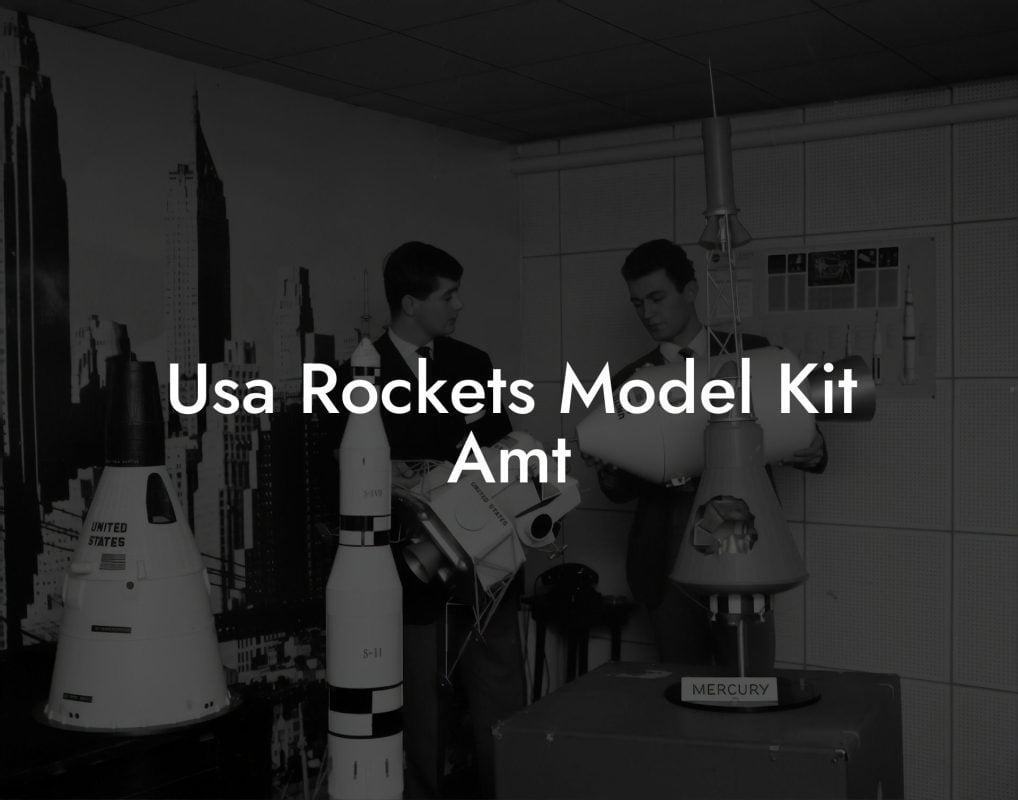Imagine soaring to new heights, defying gravity, and exploring the thrill of space travel – all from the comfort of your backyard or local park. Welcome to the world of model rockets, where the magic of aerospace engineering meets creativity, curiosity, and a dash of adventure. In this comprehensive guide, we'll blast off into the fascinating realm of model rockets, exploring the science, technology, and excitement behind these miniature marvels.
Quick Links to Useful Sections
- The Basics of Model Rockets: Understanding the Fundamentals
- Propulsion Systems: The Heart of Model Rocketry
- Chemical Propulsion
- Water Propulsion
- Electric Propulsion
- Aerodynamics and Stability: The Science of Flight
- Control Systems: Guiding Your Rocket to New Heights
- Recovery Systems
- Stabilization Systems
- Navigation Systems
- Building and Customizing Your Model Rocket
- Model Rocketry Communities and Resources
- Frequently Asked Questions: Model Rocketry 101
- Resources and Community Support: Your Next Steps
The Basics of Model Rockets: Understanding the Fundamentals
Before we dive into the intricacies of model rocketry, let's cover the essentials. A model rocket is a small, self-contained device that uses a combination of aerodynamics, propulsion, and control systems to ascend into the air. Typically made of lightweight materials like plastic, wood, or carbon fiber, these rockets are designed to be safe, affordable, and easy to launch.
The three primary components of a model rocket are:
- Nose Cone: The pointed tip of the rocket, responsible for reducing air resistance and protecting the payload during ascent.
- Fuselage: The main body of the rocket, housing the propulsion system, control mechanisms, and payload.
- Fins: The stabilizing structures at the rear of the rocket, providing balance and direction during flight.
Propulsion Systems: The Heart of Model Rocketry
The propulsion system is the driving force behind a model rocket's flight. There are several types of propulsion systems, each with its advantages and limitations:
Chemical Propulsion
This is the most common type of propulsion system, using a combustible fuel (such as black powder or ammonium perchlorate) to produce thrust. Chemical propulsion systems are reliable, efficient, and easy to use.
Looking For The Best Model Rocket Kits? You'll Love These:
Water Propulsion
Water propulsion systems use compressed air or water to generate thrust. These systems are safer, more environmentally friendly, and often more cost-effective than chemical propulsion.
Electric Propulsion
Electric propulsion systems utilize electric motors to accelerate a propellant, such as air or water, to generate thrust. These systems are highly efficient, quiet, and suitable for smaller model rockets.
Aerodynamics and Stability: The Science of Flight
Aerodynamics and stability are crucial aspects of model rocket design. By understanding the principles of air resistance, drag, and lift, model rocket enthusiasts can create more efficient, stable, and agile rockets.
Key factors influencing aerodynamics and stability include:
- Shape and Size: The rocket's shape and size affect air resistance, with sleeker, more streamlined designs reducing drag.
- Fins and Control Surfaces: The size, shape, and angle of fins and control surfaces impact stability and direction during flight.
- Weight Distribution: The distribution of weight within the rocket affects its center of gravity, influencing stability and flight performance.
Control Systems: Guiding Your Rocket to New Heights
Control systems play a vital role in model rocketry, ensuring that your rocket reaches its desired altitude and returns safely to Earth. Common control systems include:
Recovery Systems
Recovery systems, such as parachutes or streamers, slow the rocket's descent, protecting it from damage and allowing for safe recovery.
Stabilization Systems
Stabilization systems, like gyroscopes or accelerometers, help maintain the rocket's orientation and stability during flight.
Navigation Systems
Navigation systems, including GPS or altimeters, track the rocket's altitude, velocity, and location, providing valuable data for future launches.
Building and Customizing Your Model Rocket
One of the most exciting aspects of model rocketry is designing and building your own rocket. With a wide range of materials, components, and software available, the possibilities are endless.
Tips for building and customizing your model rocket:
- Choose the Right Materials: Select materials that balance strength, weight, and durability.
- Design for Aerodynamics: Optimize your rocket's shape and size for minimal air resistance.
- Experiment with Propulsion Systems: Try different propulsion systems to find the one that suits your needs.
Model Rocketry Communities and Resources
Joining a model rocketry community or seeking out online resources can help you connect with like-minded enthusiasts, learn new techniques, and stay up-to-date with the latest developments in the field.
Some popular model rocketry communities and resources include:
- National Association of Rocketry (NAR): A leading organization for model rocket enthusiasts, offering resources, events, and competitions.
- Model Rocketry Forum: An online community dedicated to discussing model rocketry, sharing knowledge, and showcasing projects.
- Rocketry Online: A comprehensive resource for model rocketry, featuring tutorials, articles, and product reviews.
Frequently Asked Questions: Model Rocketry 101
Got questions about model rocketry? We've got answers!
1. What is the highest altitude a model rocket can reach?
The highest altitude recorded by a model rocket is around 36,000 feet (10,973 meters).
2. Are model rockets safe?
Yes, model rockets are designed to be safe when used properly. Always follow safety guidelines and precautions when launching and handling model rockets.
3. Can I build a model rocket that can carry a payload?
Yes, many model rockets are designed to carry small payloads, such as cameras, sensors, or even tiny animals.
4. How long do model rockets typically fly?
Flight times vary depending on the rocket's design, propulsion system, and altitude. Typical flight times range from 10 seconds to several minutes.
5. Can I launch a model rocket in any weather conditions?
No, it's essential to check weather conditions before launching a model rocket. Avoid launching in strong winds, heavy rain, or extreme temperatures.
Resources and Community Support: Your Next Steps
Now that you've explored the world of model rockets, it's time to take your passion to new heights. Join online communities, attend local model rocketry events, and continue learning from experienced enthusiasts.
Remember, model rocketry is a journey, not a destination. Embrace the thrill of experimentation, the joy of creation, and the camaraderie of the model rocketry community.
Happy launching!
Looking For The Best Model Rocket Kits? You'll Love These:
Useful Interruption: Dive deeper into the world of Model Rockets with our most popular sections. If there is anything you think is missing or anything you would love for us to write about, just give us a shout.
- Getting Started & Basics With Model Rockets
- Model Rocket Design, Build & Customization
- Model Rocket Propulsion & Engine Technology
- Model Rocket Launch Techniques & Recovery
- Model Rocket Advanced Rocketry & Innovations
- Model Rocket DIY and Customization
- Model Rocket Equipment Reviews & Digital Tools
- Community, Competitions & Education
- Model Rocket Troubleshooting & FAQs
- Model Rocket Bonus/Seasonal & Niche Topics
A group of model rocket enthusiasts gathered at a field for their weekly launch event. Among them was Dave, a seasoned builder known for pushing the limits of hobby rocketry. This time, he had outdone himself.
“Ladies and gentlemen,” Dave announced, dramatically pulling a cloth off his latest creation, “I present to you: The Kraken!”
The crowd gasped. This wasn’t just a model rocket, it was a monster. The thing stood 8 feet tall, had six clustered engines, and was covered in enough duct tape to qualify as a classified aerospace project.
“Dave,” muttered Steve, the cautious safety officer, “Have you, uh… done the math on this?”
“Math?” Dave scoffed. “I built it in my garage at 3 a.m. with parts from eBay. This is an art piece, Steve.”
The countdown began.
5…
4…
3…
2…
1…
The engines ignited with a BOOM, and The Kraken shot up… kind of. It immediately did a violent barrel roll, narrowly missing the spectators before skyrocketing at an angle that could only be described as “legally questionable.”
The crowd collectively ducked as The Kraken flew straight over the adjacent cornfield, where Old Man Jenkins, the grumpiest farmer in town, was minding his business.
KABOOM!
The rocket disappeared behind the barn. A moment later, a flaming piece of Estes igniter wire landed at Steve’s feet. The silence was deafening.
And then, an unmistakable sound echoed across the field.
Jenkins’ shotgun being cocked.
“DAVE!!!” Steve shouted. “RUN.”
And that was the day Dave invented the first-ever biologically powered rocket booster: pure adrenaline.
To this day, nobody knows where The Kraken landed, but legend has it, it still haunts the skies, terrifying unsuspecting drones and low-flying birds.















